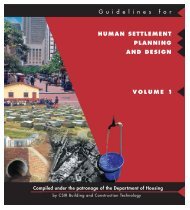METHOD A1 THE WET PREPARATION AND SIEVE ANALYSIS OF ...
METHOD A1 THE WET PREPARATION AND SIEVE ANALYSIS OF ...
METHOD A1 THE WET PREPARATION AND SIEVE ANALYSIS OF ...
You also want an ePaper? Increase the reach of your titles
YUMPU automatically turns print PDFs into web optimized ePapers that Google loves.
down to a slurry which is then dried in an oven at a temperature of 105 to 110 EC (see<br />
5.4). The dried soil in the bottom of the basin is loosened with a stiff wire brush or<br />
with a spatula in the case of clayey soils. The material adhering to the sides of the<br />
basin is brushed down and the slurry is disintegrated as far as possible with the brush.<br />
The material is sieved through the 0,425 mm sieve and clods retained on the sieve are<br />
disintegrated in the mortar with a rubber-tipped pestle, or if too hard, with the iron<br />
pestle. It is not necessary to crush very finely--just sufficiently to enable all the<br />
material to pass the 0,425 mm sieve. The soil fines are added to the portion obtained<br />
by dry sieving as described in 3.3.<br />
3.6 Sieve analysis<br />
After drying, the material retained on the 0,425 mm sieve is sieved through a nest of<br />
sieves consisting of the following: 63,0 mm, 53,0 mm, 37,5 mm, 26,5 mm, 19,0 mm,<br />
13,2 mm, 4,75 mm, 2,0 mm and 0,425 mm. The sieving should be thorough and be<br />
done either by hand or by means of a mechanical sieve shaker. On no account should<br />
any sieve be overloaded as some of the fine material may be kept back if the layer on<br />
the sieve is too deep. If necessary, the material should be divided into fractions which<br />
are then sieved separately. After sieving, the material retained on each sieve is<br />
weighed and the masses recorded in the appropriate column of Form <strong>A1</strong>/1 (or a<br />
similar form). Weighings should be accurate to the nearest 1 gram. The material<br />
passing the 0,425 mm sieve is added to the soil fines portions obtained by dry sieving<br />
and by washing. All this material is now transferred to the scoop of the scale (or other<br />
similar container) where it is thoroughly mixed by stirring. It is then weighed and<br />
returned to the paper bag ready for the mechanical analysis and for the determination<br />
of the Atterberg constants and the linear shrinkage.<br />
4 CALCULATIONS<br />
The mass of each fraction retained between two sieves and the fraction passing the<br />
0,425 mm sieve is converted to a percentage of the total mass of the dry material.<br />
(The mass of the original test sample is merely determined to serve as a check that no<br />
serious error has been made. This latter mass will normally be some- what higher than<br />
that of the dry material due to the presence of hygroscopic moisture.) The percentage<br />
retained on each sieve is then converted to a percentage passing the sieve. The<br />
percentages are calculated and reported to the nearest whole number on the appended<br />
<strong>A1</strong>/2 (or similar) Form and/or plotted on a suitable grading sheet such as the <strong>A1</strong>/3<br />
Form.<br />
5 NOTES<br />
5.1 I n cases where the quantity of the different sizes of coarse aggregate in the field<br />
sample is such that it cannot be subdivided into a reasonably representative portion by<br />
coning and quartering, the sieve analysis carried out on the relatively small test<br />
sample will be far from accurate. A sieve analysis is, therefore, carried out on all the<br />
aggregate retained on the 19,0 mm sieve using a nest of 300 mm diameter sieves with<br />
openings from 63,0 mm to 19,0 mm. Seeing that in this case the aggregate is not<br />
subjected to the usual boiling and washing, care should be taken to remove any soil<br />
adhering to the aggregate before the sieve analysis is carried out. The actual test

















